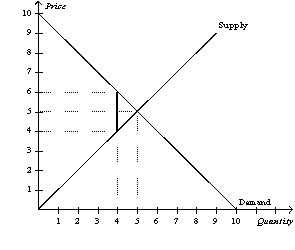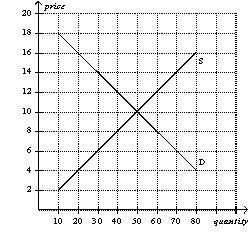A) falls, and the wage paid by firms rises.
B) falls, and the wage paid by firms falls.
C) rises, and the wage paid by firms falls.
D) rises, and the wage paid by firms rises.
Correct Answer

verified
Correct Answer
verified
Multiple Choice
To say that a price floor is binding is to say that the price floor
A) results in a shortage.
B) is set below the equilibrium price.
C) causes quantity supplied to exceed quantity demanded.
D) All of the above are correct.
Correct Answer

verified
Correct Answer
verified
True/False
Figure 6-27
 -Refer to Figure 6-27.If the government places a $2 tax in the market,the seller receives $4.
-Refer to Figure 6-27.If the government places a $2 tax in the market,the seller receives $4.
Correct Answer

verified
Correct Answer
verified
Multiple Choice
Price controls
A) always produce a fair outcome.
B) always produce an efficient outcome.
C) can generate inequities of their own.
D) All of the above are correct.
Correct Answer

verified
Correct Answer
verified
Multiple Choice
The price paid by buyers in a market will decrease if the government
A) increases a binding price floor in that market.
B) increases a binding price ceiling in that market.
C) decreases a tax on the good sold in that market.
D) All of the above are correct.
Correct Answer

verified
Correct Answer
verified
True/False
Minimum-wage laws benefit society by creating a surplus of labor.
Correct Answer

verified
Correct Answer
verified
True/False
When a free market for a good reaches equilibrium,anyone who is willing and able to pay the market price can buy the good.
Correct Answer

verified
Correct Answer
verified
True/False
Figure 6-27
 -Refer to Figure 6-27.If the government places a $2 tax in the market,the buyer bears $1 of the tax burden.
-Refer to Figure 6-27.If the government places a $2 tax in the market,the buyer bears $1 of the tax burden.
Correct Answer

verified
Correct Answer
verified
Multiple Choice
A tax imposed on the sellers of a good will lower the
A) price paid by buyers and lower the equilibrium quantity.
B) price paid by buyers and raise the equilibrium quantity.
C) effective price received by sellers and lower the equilibrium quantity.
D) effective price received by sellers and raise the equilibrium quantity.
Correct Answer

verified
Correct Answer
verified
Multiple Choice
The price received by sellers in a market will increase if the government
A) decreases a binding price floor in that market.
B) increases a binding price ceiling in that market.
C) increases a tax on the good sold in that market.
D) imposes a binding price ceiling in that market.
Correct Answer

verified
Correct Answer
verified
Multiple Choice
Figure 6-6
 -Refer to Figure 6-6.Which of the following statements is not correct?
-Refer to Figure 6-6.Which of the following statements is not correct?
A) A price ceiling set at $8 would be binding, but a price ceiling set at $12 would not be binding.
B) A price floor set at $14 would be binding, but a price floor set at $8 would not be binding.
C) A price ceiling set at $9 would result in a surplus.
D) A price floor set at $11 would result in a surplus.
Correct Answer

verified
Correct Answer
verified
Multiple Choice
If a price floor is not binding,then
A) the equilibrium price is above the price floor.
B) the equilibrium price is below the price floor.
C) there will be a surplus in the market.
D) Both a) and c) are correct.
Correct Answer

verified
Correct Answer
verified
Multiple Choice
A tax on buyers will shift the
A) demand curve upward by the amount of the tax.
B) demand curve downward by the amount of the tax.
C) supply curve upward by the amount of the tax.
D) supply curve downward by the amount of the tax.
Correct Answer

verified
Correct Answer
verified
Multiple Choice
If the government wants to reduce the burning of fossil fuels,it should impose a tax on
A) buyers of gasoline.
B) sellers of gasoline.
C) either buyers or sellers of gasoline.
D) whichever side of the market is less elastic.
Correct Answer

verified
Correct Answer
verified
True/False
One common example of a price floor is the minimum wage.
Correct Answer

verified
Correct Answer
verified
True/False
Price floors are typically imposed to benefit sellers.
Correct Answer

verified
Correct Answer
verified
Multiple Choice
Minimum-wage laws dictate the
A) average price employers must pay for labor.
B) highest price employers may pay for labor.
C) lowest price employers may pay for labor.
D) the highest and lowest prices employers may pay for labor.
Correct Answer

verified
Correct Answer
verified
Multiple Choice
Rent control policies tend to cause
A) relatively smaller shortages in the short run than in the long run because supply and demand tend to be more elastic in the short run than in the long run.
B) relatively larger shortages in the short run than in the long run because supply and demand tend to be more elastic in the short run than in the long run.
C) relatively larger shortages in the short run than in the long run because supply and demand tend to be more inelastic in the short run than in the long run.
D) relatively smaller shortages in the short run than in the long run because supply and demand tend to be more inelastic in the short run than in the long run.
Correct Answer

verified
Correct Answer
verified
Multiple Choice
Figure 6-1
 -Refer to Figure 6-1.A binding price ceiling is shown in
-Refer to Figure 6-1.A binding price ceiling is shown in
A) panel (a) only.
B) panel (b) only.
C) both panel (a) and panel (b) .
D) neither panel (a) nor panel (b) .
Correct Answer

verified
Correct Answer
verified
True/False
When a tax is imposed on a good,the result is always a shortage of the good.
Correct Answer

verified
Correct Answer
verified
Showing 41 - 60 of 557
Related Exams